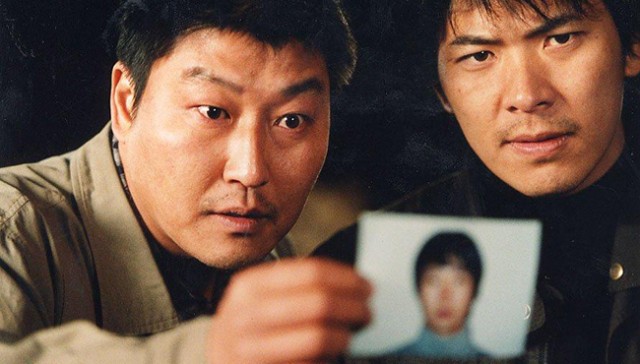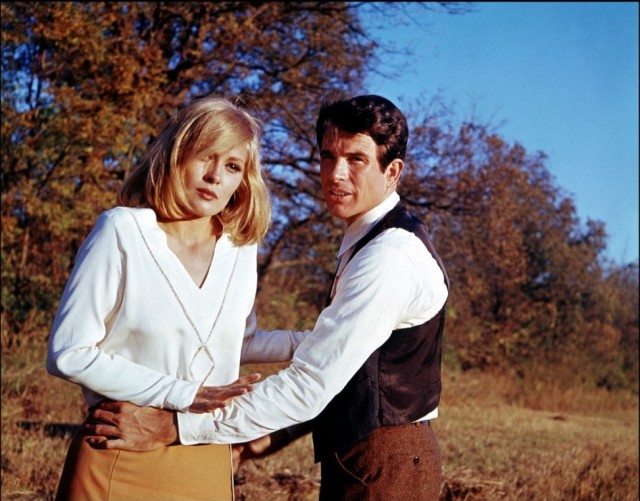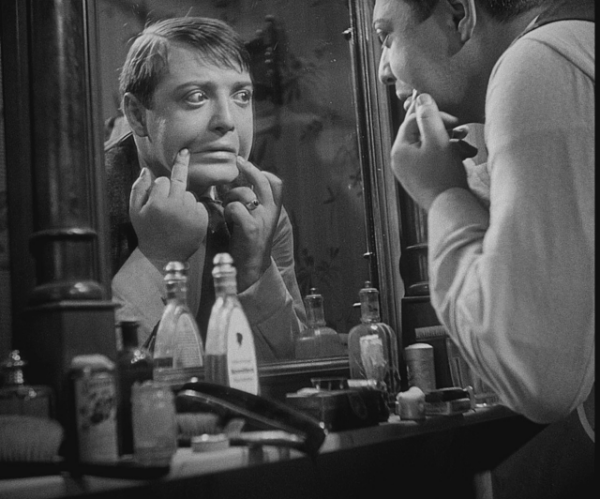
Hans Beckert (Peter Lorre) takes a good look at himself in Fritz Lang classic
M (Fritz Lang, 1931)
Film Forum
209 West Houston St.
Wednesday, July 22, 10:00
Series continues through August 5
212-727-8110
filmforum.org
 Fritz Lang’s first sound film, following such classic silent works as Metropolis and Die Nibelungen, is a masterpiece of precision, a crime thriller nonpareil in its examination of a serial killer, mob justice, and the psychological nature of good and evil. In M — Eine Stadt sucht einen Mörder, Peter Lorre stars as Hans Beckert, a creepy young man who befriends children before abducting and murdering them. Even with a reward out for his capture, he can’t stop himself from taking yet more little girls, in broad daylight, and writing letters to the police and a local newspaper, practically daring them to catch him. As his spree continues, the local community grows more and more frightened and suspicious, and men and women start looking suspiciously at anyone who even so much as nods to a child on the streets, mass hysteria beckoning. As the police try to figure out a plan of action, the criminals band together and hire beggars to try to track down Beckert, since the larger police presence is negatively impacting their business. Eventually, Beckert, who has a fondness for whistling Edvard Grieg’s “In the Hall of the Mountain King,” is spotted with a child, leading to a series of scenes that are simply spectacular in the flow of their movement as the riveting denouement approaches.
Fritz Lang’s first sound film, following such classic silent works as Metropolis and Die Nibelungen, is a masterpiece of precision, a crime thriller nonpareil in its examination of a serial killer, mob justice, and the psychological nature of good and evil. In M — Eine Stadt sucht einen Mörder, Peter Lorre stars as Hans Beckert, a creepy young man who befriends children before abducting and murdering them. Even with a reward out for his capture, he can’t stop himself from taking yet more little girls, in broad daylight, and writing letters to the police and a local newspaper, practically daring them to catch him. As his spree continues, the local community grows more and more frightened and suspicious, and men and women start looking suspiciously at anyone who even so much as nods to a child on the streets, mass hysteria beckoning. As the police try to figure out a plan of action, the criminals band together and hire beggars to try to track down Beckert, since the larger police presence is negatively impacting their business. Eventually, Beckert, who has a fondness for whistling Edvard Grieg’s “In the Hall of the Mountain King,” is spotted with a child, leading to a series of scenes that are simply spectacular in the flow of their movement as the riveting denouement approaches.
In making M, Lang was inspired by real events involving multiple serial killers. Although the film in no way preaches, Lang, who cowrote the script with his then-wife, Thea von Harbou, considered M very much a message picture. On May 20, 1931, he wrote in the German newspaper Die Filmwoche, “If this film based on factual reports helps to point an admonishing and warning finger at the unknown, lurking threat, the chronic danger emanating from the constant presence among us of compulsively and criminally inclined individuals, forming, so to speak, a latent potential that may devour our lives in flames—and especially the lives of the most helpless among us—and if the film also helps, perhaps, even to avert this danger, then it will have served its highest purpose and drawn the logical conclusion from the quintessential facts assembled in it.” M feels eerily prescient and especially relevant today, when parents’ fear for the safety of their children has perhaps never been greater. Seeing adults waiting outside schools, praying for their kids to be out of harm’s way, is something that can now be witnessed across America day after day.

Hans Beckert (Peter Lorre) doesn’t like what he sees in M
Lorre (The Man Who Knew Too Much, The Maltese Falcon) is exceptional as Beckert, a baby-faced man who might not be quite as evil as everyone imagines. Lang and cinematographer Fritz Arno Wagner (Nosferatu, Diary of a Lost Girl) regularly show Beckert in shadow and in mirrors, as if there are two sides to this child killer. Lang uses no musical score, instead allowing natural sound, and very often pure silence, as Lang (Fury, Ministry of Fear) recognizes that he doesn’t need to overplay his hand. As depicted in the film, if there’s one thing that everyone can agree on, from cops and criminals to blind balloon sellers and mothers and fathers, it’s that there is nothing worse than a man who murders children. Yet Lang ultimately is able to extract some sympathy for Beckert, who makes a powerful plea near the end of the film. Watching M is a gripping, unforgettable experience, despite its terrifying subject matter.
M is screening July 22 at 10:00 as part of Film Forum’s “True Crime” series, which continues through August 5 with such other ripped-from-the-headlines favorites as Sidney Lumet’s Serpico and Dog Day Afternoon, Tadashi Imai’s Darkness at Noon, John McNaughton’s Henry: Portrait of a Serial Killer, and double features of Richard Fleischer’s The Girl in the Red Velvet Swing and Compulsion and William Friedkin’s The French Connection and The Brink’s Job.
 Based on the novel by Joseph Kessel (Belle de Jour), Jean-Pierre Melville’s 1969 WWII drama Army of Shadows got its first theatrical release in America in 2006, in a restored 35mm print supervised by the film’s cinematographer, Pierre Lhomme, who shot it in a beautiful blue-gray palette. The film centers on a small group of French resistance fighters, including shadowy leader Luc Jardie (Paul Meurisse), the smart and determined Mathilde (Simone Signoret), the nervous Jean-François (Jean-Pierre Cassel), the steady and dependable Felix (Paul Crauchet), the stocky Le Bison (Christian Barbier), the well-named Le Masque (Claude Mann), and the unflappable and practical Gerbier (Lino Ventura). Although Melville, who was a resistance fighter as well, wants the film to be his personal masterpiece, he is too close to the material, leaving large gaps in the narrative and giving too much time to scenes that don’t deserve them. He took offense at the idea that he portrayed the group of fighters as gangsters, yet what shows up on the screen is often more film noir than war movie. However, there are some glorious sections of Army of Shadows, including Gerbier’s escape from a Vichy camp, the execution of a traitor to the cause, and a tense Mission: Impossible–like (the TV series, not the Tom Cruise vehicles) attempt to free the imprisoned Felix. But most of all there is Ventura, who gives an amazingly subtle performance that makes the overly long film (nearly two and a half hours) worth seeing all by itself. Army of Shadows is once again back at Film Forum for a special one-week return engagement August 26 – September 1.
Based on the novel by Joseph Kessel (Belle de Jour), Jean-Pierre Melville’s 1969 WWII drama Army of Shadows got its first theatrical release in America in 2006, in a restored 35mm print supervised by the film’s cinematographer, Pierre Lhomme, who shot it in a beautiful blue-gray palette. The film centers on a small group of French resistance fighters, including shadowy leader Luc Jardie (Paul Meurisse), the smart and determined Mathilde (Simone Signoret), the nervous Jean-François (Jean-Pierre Cassel), the steady and dependable Felix (Paul Crauchet), the stocky Le Bison (Christian Barbier), the well-named Le Masque (Claude Mann), and the unflappable and practical Gerbier (Lino Ventura). Although Melville, who was a resistance fighter as well, wants the film to be his personal masterpiece, he is too close to the material, leaving large gaps in the narrative and giving too much time to scenes that don’t deserve them. He took offense at the idea that he portrayed the group of fighters as gangsters, yet what shows up on the screen is often more film noir than war movie. However, there are some glorious sections of Army of Shadows, including Gerbier’s escape from a Vichy camp, the execution of a traitor to the cause, and a tense Mission: Impossible–like (the TV series, not the Tom Cruise vehicles) attempt to free the imprisoned Felix. But most of all there is Ventura, who gives an amazingly subtle performance that makes the overly long film (nearly two and a half hours) worth seeing all by itself. Army of Shadows is once again back at Film Forum for a special one-week return engagement August 26 – September 1.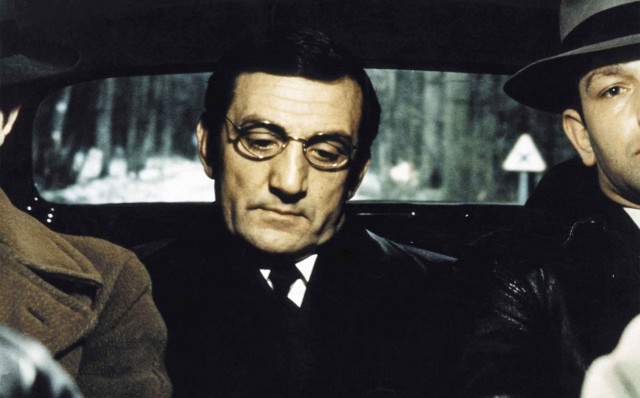
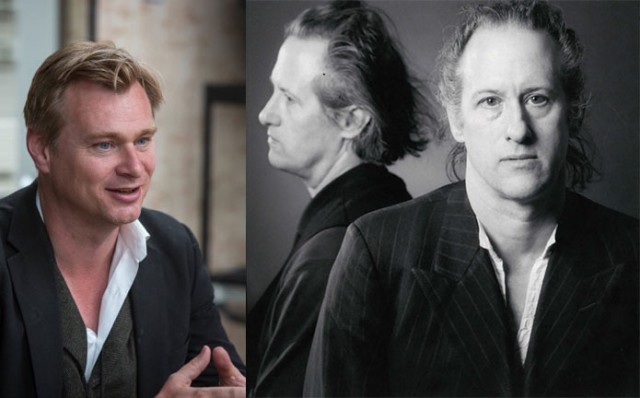
 In such films as Memento, Inception, and Interstellar, British-American writer-director Christopher Nolan has shown a flair for unusual storytelling devices and complex narratives. “I decided to structure my story in such a way as to emphasize the audience’s incomplete understanding of each new scene as it is first presented,” he said about his debut feature, 1998’s Following, and a similar aesthetic can be applied to the works of the Quay Brothers. Pennsylvania-born, England-based twins Stephen and Timothy Quay have been making complex narratives for three dozen years, short films and feature-length tales that push the boundaries of storytelling conventions. In hypnotic films such as In Absentia, The Comb (From the Museums of Sleep), and their universally acclaimed masterpiece, Street of Crocodiles, they use fragile dolls and puppets, psychologically tantalizing Expressionistic imagery, and experimental music to draw viewers into their Gothic, industrial, dreamlike fantasy world. In fall 2009, their mind-blowing sets were on display in the exhibit
In such films as Memento, Inception, and Interstellar, British-American writer-director Christopher Nolan has shown a flair for unusual storytelling devices and complex narratives. “I decided to structure my story in such a way as to emphasize the audience’s incomplete understanding of each new scene as it is first presented,” he said about his debut feature, 1998’s Following, and a similar aesthetic can be applied to the works of the Quay Brothers. Pennsylvania-born, England-based twins Stephen and Timothy Quay have been making complex narratives for three dozen years, short films and feature-length tales that push the boundaries of storytelling conventions. In hypnotic films such as In Absentia, The Comb (From the Museums of Sleep), and their universally acclaimed masterpiece, Street of Crocodiles, they use fragile dolls and puppets, psychologically tantalizing Expressionistic imagery, and experimental music to draw viewers into their Gothic, industrial, dreamlike fantasy world. In fall 2009, their mind-blowing sets were on display in the exhibit 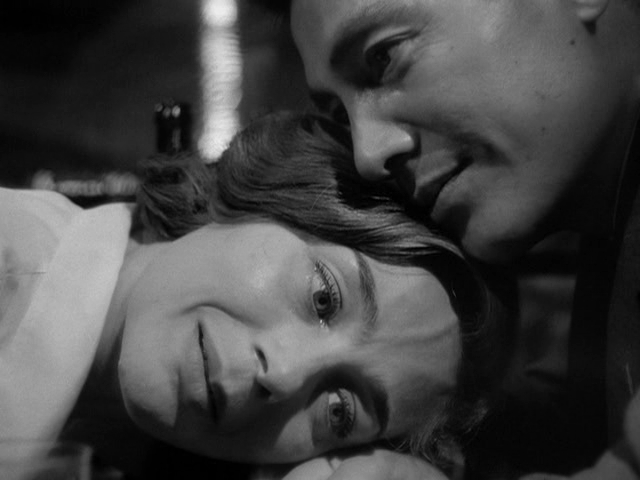
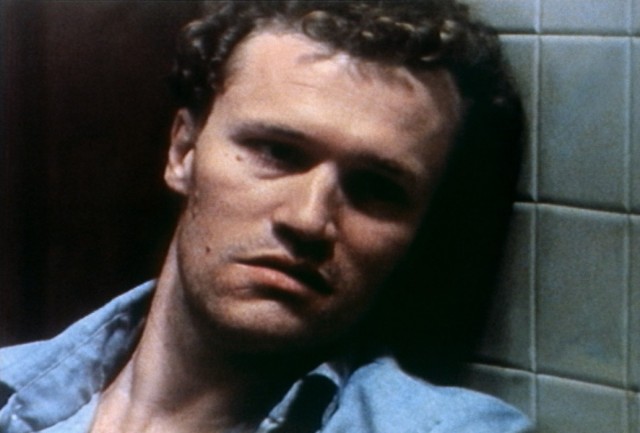
 More than twenty-five years ago, when director John McNaughton (Mad Dog and Glory, Wild Things) was asked by executive producers Malik B. and Waleed B. Ali to make a low-budget horror film, he and cowriter Richard Fire decided to base their tale on the exploits of serial killer Henry Lee Lucas, whose story McNaughton had just seen on 20/20. The result was this creepy, dark, well-paced effort starring Michael Rooker as Henry, a brooding, casual serial killer who can’t quite remember how he murdered his mother. Henry lives in suburban Chicago with ex-con Otis (Tom Towles), whose sexy young sister, Becky (Tracy Arnold), comes to stay with them to get away from her abusive husband. As the relationship among the three of them grows more and more complicated, Henry continues to kill people — and get away with it. The opening tableau of some of Henry’s murder victims — the actual killings aren’t shown in the beginning — is beautifully done, although it also fetishizes violence against women, which is extremely disturbing. (Several of the victims are played by the same woman, Mary Demas, in different wigs.) Henry, which was not released until 1989 because of its graphic content, was nominated for six Independent Spirit Awards in 1990, and Rooker was named Best Actor at the Seattle International Film Festival. The film is screening July 30 as part of Film Forum’s “True Crime” series, which continues through August 5 with such other ripped-from-the-headlines tales as Charlie Chaplin’s Monsieur Verdou, Alain Resnais’s Stavisky, Leonard Kastle’s The Honeymoon Killers, and a double features of Barbet Schroeder’s Reversal of Fortune and Peter Medak’s The Krays.
More than twenty-five years ago, when director John McNaughton (Mad Dog and Glory, Wild Things) was asked by executive producers Malik B. and Waleed B. Ali to make a low-budget horror film, he and cowriter Richard Fire decided to base their tale on the exploits of serial killer Henry Lee Lucas, whose story McNaughton had just seen on 20/20. The result was this creepy, dark, well-paced effort starring Michael Rooker as Henry, a brooding, casual serial killer who can’t quite remember how he murdered his mother. Henry lives in suburban Chicago with ex-con Otis (Tom Towles), whose sexy young sister, Becky (Tracy Arnold), comes to stay with them to get away from her abusive husband. As the relationship among the three of them grows more and more complicated, Henry continues to kill people — and get away with it. The opening tableau of some of Henry’s murder victims — the actual killings aren’t shown in the beginning — is beautifully done, although it also fetishizes violence against women, which is extremely disturbing. (Several of the victims are played by the same woman, Mary Demas, in different wigs.) Henry, which was not released until 1989 because of its graphic content, was nominated for six Independent Spirit Awards in 1990, and Rooker was named Best Actor at the Seattle International Film Festival. The film is screening July 30 as part of Film Forum’s “True Crime” series, which continues through August 5 with such other ripped-from-the-headlines tales as Charlie Chaplin’s Monsieur Verdou, Alain Resnais’s Stavisky, Leonard Kastle’s The Honeymoon Killers, and a double features of Barbet Schroeder’s Reversal of Fortune and Peter Medak’s The Krays.

